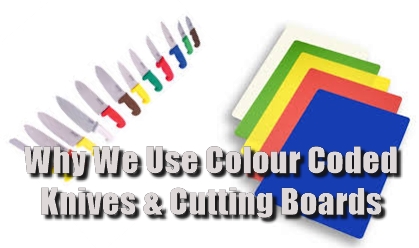Kitchen knives reflect the designs and cooking techniques that follow traditions in the part of the world where they were developed and as with all professional kitchen equipment, quality is reflected in the price, you get what you pay for.
How knives are made …
The most common way of making a knife blade, bolster and tang is to drop-forge it, which means putting a piece of red-hot stainless steel in the lower half of a mould and stamping down on it with a huge force to form the basis of the knife. Some manufacturers prefer to fuse together three different grades of metal for the three parts of the knife, believing that each part needs a different steel quality.
The blade is then tempered with heat to create extra hardness, polished, fitted with a handle and sharpened. The higher quality the steel, the sharper will be the edge and the longer it will remain without needing re-sharpening. Low grade stainless steel kitchen knives are unable to hold an edge much beyond first using and hand-steeling will fail to bring back the edge. It pays in the long term to invest in quality kitchen knives.
The traditional way to fit a handle is to rivet a solid handle in two halves (traditionally in Western cuisine the black handles), but cheaper knives will come with a single-formed solid plastic handle. A plastic handle is not always an indicator of poor quality blade steel any more than riveted handles are a signal of high quality. Balance is very important in kitchen knife construction. There should be a good counter-balance between handle and blade so that the knife sits level in the hand for quick and comfortable working.
There are two styles of kitchen knives
Oriental style knives such as Japanese are made from very hard steel, the blades are significantly thinner, producing a lighter weight knife and the bevel angles are more acute. These knives will hold an edge for longer, but will also take longer to sharpen. They are good for cutting where accuracy is important, such as preparing Sushi or doing decorative work.
The Japanese also make knives that incorporate a chisel grind. This is a bevel on one side with the other side flat. These are usually made from what is called sandwiched steels, where a hard steel for edge retention is sandwiched between soft steel or even iron to provide better toughness. They do an excellent job with Eastern or Oriental style cooking where there is much fine chopping, but their sharpness is also a feature many Western chefs like.
Western knives are made from tough steel, but slightly softer than Japanese knives which makes them easier to maintain a sharp edge on. They tend to be thicker and heavier with a more obtuse bevel angle. These are perfect for chopping and for those jobs where a heavier knife is an advantage.
There are three types of steel used in kitchen knives
High carbon steel – An excellent material, providing toughness and the ability to take a very sharp edge. However, carbon steel is not stain resistant. It can rust and will discolour from use. After much use, high carbon steel kitchen knife blades will actually become black. This discoloration is purely cosmetic and does not affect the performance of the knife in any way.
High carbon stainless steel – The most popular steel for kitchen knives. It has a high content of carbon for hardness, but chromium and nickel to keep it looking clean. High carbon stainless will take a sharp edge and maintain it well.
Titanium enhanced – These blades will hold an edge longer than most other steel alloys. The alloy mix allow the blades to be heat treated to a high level of hardness. The blades are more flexible than standard steel blades so work well for boning, and filleting.
In addition ceramic knives have become popular in recent years. Ceramic is not a steel at all, but a very hard ceramic material called zirconium oxide. These blades are so hard that they will maintain a sharp edge for months or years with no maintenance at all. On the negative side, they require diamond sharpening tools to maintain and are generally considerably more expensive than traditional steel knives.
